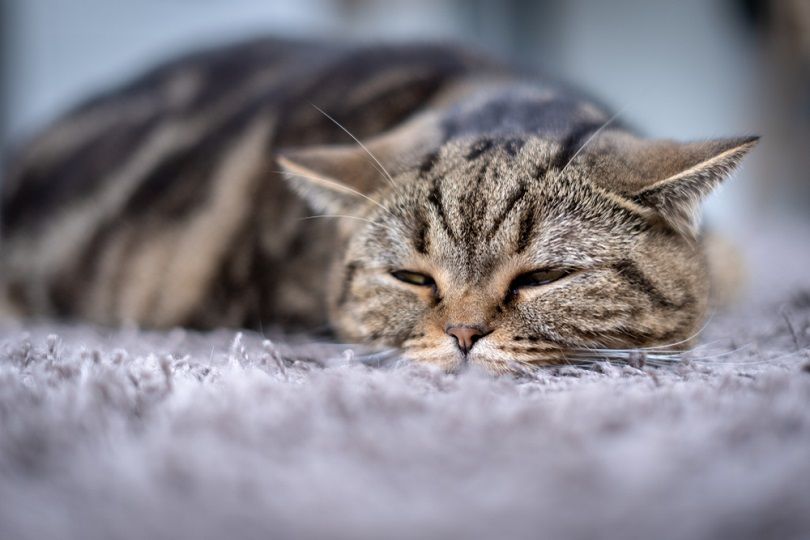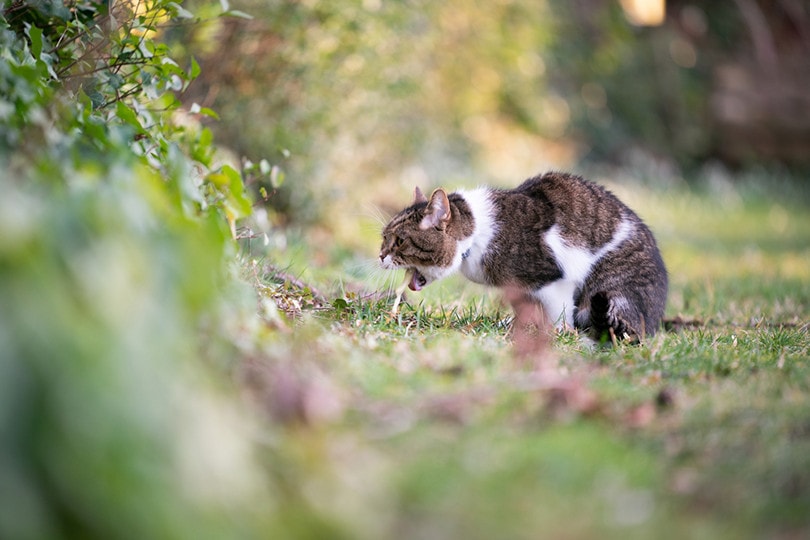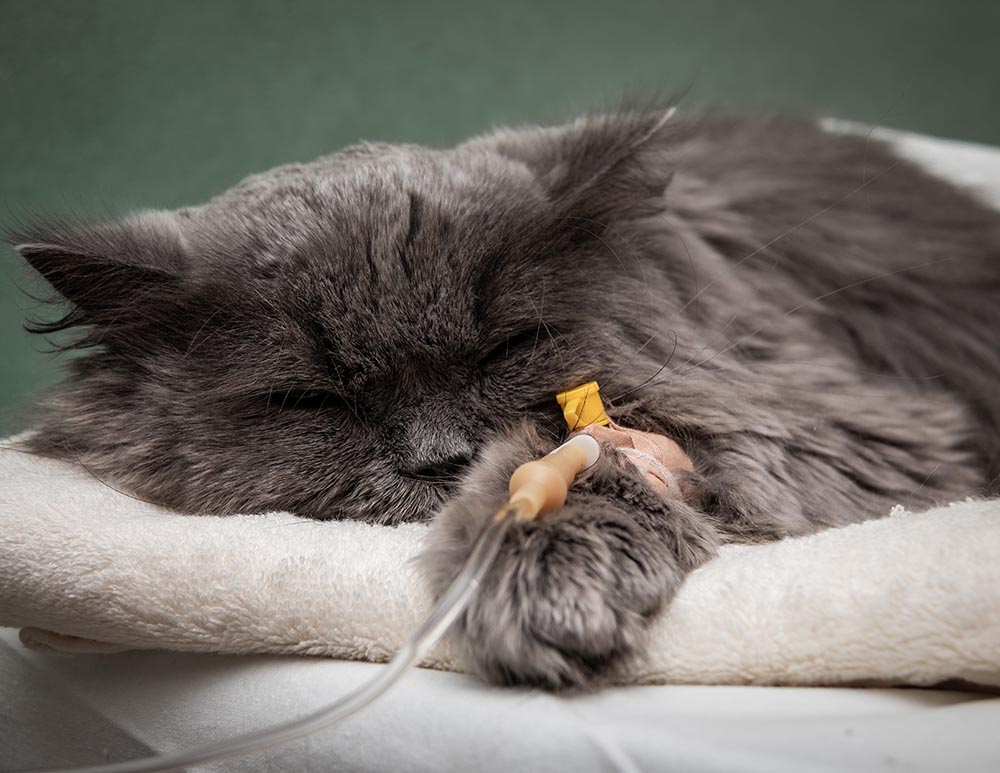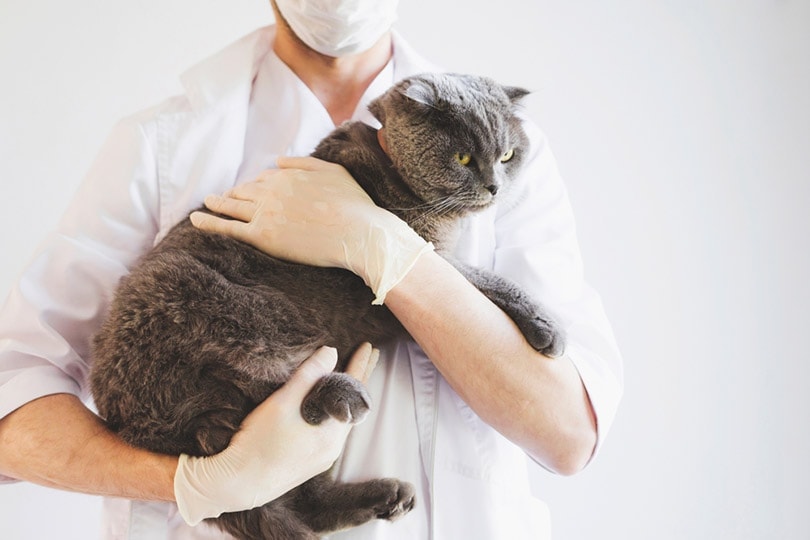
Historically, feline panleukopenia was a significant cause for concern in our feline friends and was very likely to cause death. Thankfully, fatal disease is now uncommon due to a widely available and very effective vaccination. Feline panleukopenia is also called feline distemper, feline parvovirus (FPV), or feline infectious enteritis (FIE).

What Is Feline Panleukopenia Virus/Feline Parvovirus?
Feline panleukopenia is a highly contagious disease caused by the “feline parvovirus” virus. This virus is different from the ones that cause “canine parvovirus” and “canine distemper” in dogs. The virus does not cause problems for people. It attacks the immune system, guts, and sometimes even the heart muscle in affected animals.
The virus spreads by “fecal-oral” transmission (exposure to infected poo) and by contamination of the environment or objects such as food bowls, bedding, clothing, or hands. Most cats get the virus from exposure to infected feces rather than directly from another infected cat. However, as the virus is in the environment, most cats will be exposed to it at some point. The virus can survive in the environment for up to one year and is challenging to kill without specific disinfectants. This makes it a significant problem in rescue facilities or cat colonies where many cats live together, especially with uncertain vaccination histories.

Which Cats Are Vulnerable to FPV?
Kittens are the most vulnerable to FPV. When they are tiny, kittens receive protection from their mother via antibodies in their milk. However, these protective antibodies do wear off, and therefore kittens are especially vulnerable around the age of 4–12 weeks. Adult cats, especially those who are unvaccinated, are also at risk.
What Are the Symptoms of Feline Panleukopenia Virus?
Not every cat that has been infected with the feline panleukopenia virus will show any clinical signs. Some may remain completely symptom-free. If they do show symptoms, you may notice any of the following:
Unfortunately, not every cat will show symptoms early in the disease, and some may die suddenly without showing any signs.
Pregnant cats infected with the disease can pass the virus to their unborn kittens. In unborn kittens, the virus can affect brain development, and when born, these kittens may have problems with balance and coordination. FPV infection can be associated with “fading kitten syndrome” or the failure to thrive.

How Might My Vet Diagnose Feline Panleukopenia Virus?
Your veterinarian will diagnose FPV based on a combination of clinical signs, blood work, and poo sample analysis. They will need to send some of these tests to an external veterinary laboratory. If your cat has sadly passed away, your veterinarian may suggest a post-mortem to reach a diagnosis.
What Is the Treatment of Feline Panleukopenia Virus?
Sadly, there is no specific treatment for feline panleukopenia virus. Cats with this disease require intensive management to treat the symptoms (vomiting, diarrhea, dehydration, loss of appetite) with fluid therapy with a drip, nursing care, assisted feeding, medications to protect the stomach, and anti-sickness medications. Antibiotics will not effectively treat the virus but may be needed if your pet develops secondary problems with their blood cell levels, which puts them at risk of infections. Some cats may benefit from treatment with a drug called “recombinant interferon.”
Can My Cat or Kitten Survive FPV?
FPV in unvaccinated animals or young kittens sadly has a high death rate. Survival is possible but usually requires intensive care in the clinic for several days to get them through it. Even with the best possible medical attention, cats and kittens may sadly still die.

How Long Does It Take to Recover from Panleukopenia (Parvovirus)?
Affected animals will usually need to be hospitalized for a minimum of several days, but sometimes this can be much longer. Typically, however, the course of the disease is no more than 5 to 7 days. Even if they recover quickly with supportive care, affected cats need to be isolated from other cats for a minimum of 2 weeks; some cats can continue to shed the virus in their poo for up to 6 weeks. Ideally, any other cats that have been in contact with the poorly cat also need to be isolated in case they have the virus without showing signs.
How Long Can a Cat Live With Feline Panleukopenia (Parvovirus)?
Severely affected animals may deteriorate and die rapidly (within hours to days). Cats that fully recover from the disease can have a normal life expectancy providing they do not have any long-lasting complications of the illness (such as heart muscle damage).

How Can I Prevent Feline Panleukopenia?
Prevention is the best course of action when it comes to feline panleukopenia. Vaccination is the single best thing to do to help protect your cat from feline panleukopenia. Vaccines do not prevent infection, but they enable the body to fight the infection much more effectively and make it extremely unlikely that your cat will become very unwell or die from the disease. Even indoor-only cats should receive this vaccination. Care should be taken with the type of vaccine given to pregnant cats or those with immune system problems. Your veterinarian will be able to advise you on the appropriate kind of vaccine for your cat.
In multi-cat households, rescue centers, or breeding colonies, strict cleaning policies with effective disinfectants can help.
If, as a breeder, you are having significant issues with fading kittens, it is worth testing your cats to assess if FPV is endemic in your colony. Your veterinarian can advise you on how to do this.

Conclusion
Feline panleukopenia is a severe and often fatal condition in unvaccinated cats. We are very fortunate to have a highly effective vaccination option available to protect our furry companions. Suppose you are worried that your kitten or cat is showing signs consistent with FPV, even if they are vaccinated. In that case, they should be seen for a check-up at your local veterinary clinic, as the condition can progress very rapidly without intensive treatment.
If you operate a rescue or breeding facility, it is essential to be strict with your biosecurity policies as prevention is the best course of action. The virus can be very challenging to destroy, and it is very infectious, so it can lead to many cats dying during an outbreak. If you are unsure about your biosecurity protocols, chat with your veterinarian, who will advise you if any improvements can be made.
See also:
- How Do You Know When Cat Labor Is Over? 6 Signs to Look For
- Why Does Dog Pee Kill Grass? What’s in Dog Pee?
Featured Image Credit: natata, Shutterstock






